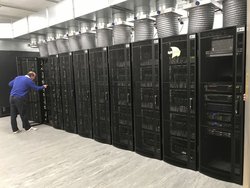
Nov. 4, 2018
By: Michael Feldman
Researchers at University of Manchester have constructed the world’s largest neuromorphic supercomputer, paving the way for real-time brain simulations.
The new million-core system, which is based on the Spiking Neural Network Architecture (SpiNNaker), was switched on for the first time on November 2. According to its developers the machine is capable of performing more that 200 trillion operations per second.

Million-Core SpiNNaker supercomputer. Source: The University of Manchester
Unlike conventional architectures, SpiNNaker mimics biological neural networks, but does so with standard processing technology, in this case Arm9 processors. Specifically, the building block of the machine is the SpiNNaker SoC, comprising 18 Arm968 processor cores integrated with a network-on-chip that performs packet-switched asynchronous communications.
The basis for its brain mimicking capability is in the way those digital assets are utilized. Instead of using a virtual model of the brain, SpiNNaker mirrows how neurons communicate with one another, sending billions of pieces of information in parallel to different processor cores. By doing this, the system can imitate the way biological neurons process information.
Twenty years in the making, the million-core SpiNNaker based on a machine half that size, which consisted of 25 24-board enclousures. Even at the that scale the system was capable of simulating hundreds of millions of neurons, equivalent to a few mouse brains. SpiNNaker’s developers expect the million-core version will eventually be able to model up to a billion neurons. At
“The ultimate objective for the project has always been a million cores in a single computer for real time brain modeling applications, and we have now achieved it, which is fantastic,” said Steve Furber, Professor of Computer Engineering.
According to Furber, up until now, these large-scale real-time brain simulations were not possible on previous versions of SpiNNaker or any other neuromorphic system. That said, a billion neurons represent only one percent of a human brain, so this latest SpiNNaker machine will still be limited to piece-meal simulations.
To date, the project has been able to model an 80,000-neuron segment of the cortex, the most highly developed part of the brain where things like perception, cognition, awareness, and language are processed. The system has also been used to model the Basal Ganglia, an area of the brain affected by Parkinson’s disease. And outside of biological simulations, SpiNNaker has been employed to control a robot.
The project was initially funded by the Engineering and Physical Sciences Research Council (EPSRC) and is now supported by the European Human Brain Project.
